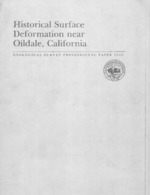Historical surface deformation near Oildale, California
Links
- More information: National Geologic Map Database Index Page (html)
- Document: Report (4.09 MB pdf)
- Plates:
- Download citation as: RIS | Dublin Core
Abstract
Historical surface deformation recognized in the southern San Joaquin Valley and adjacent Sierra Nevada foothills near Oildale, Calif., includes: normal and apparently aseismic dip slip along four faults; subsidence within or adjacent to the Kern Front, Poso Creek, Mount Poso, and Fruitvale oil fields; and uplift of much of the area within and north of the Kern River oil field. As much as 0.34 m of vertical separation has been observed along a 5.2-km segment of the Kern Front fault, the structural barrier separating the Kern Front oil field on the west from the Kern River field to the east. Similar separations of as much as 0.15 m and 0.32 m, respectively, have also been identified along the surface traces of two en echelon faults between the Premier and Enas areas of the Poso Creek oil field and the fault that defines the southeast flank of the Premier area. The measured height changes are based on both unadjusted observed elevations and minimally constrained adjusted elevations developed from repeated control levelings referred to a relatively stable local bench mark; measurement error in the reported vertical movements probably is less than 0.05 m. Differential subsidence of at least 0.31 m (1903-68) and 0.05 m (1926/27/30/31-59) has occurred within the Kern Front and Fruitvale oil fields, respectively; subsidence of as much as 0.33 m (1903-53) and 0.19 m (1931-63) has also been measured along the north edge of the Premier area of the Poso Creek oil field and the south edge of the Main area of the Mount Poso field, respectively. Differential uplift of as much as 0.11 m and 0.13 m occurred within and immediately north of the Kern River oil field between 1903 and 1968, and similar uplift of as much as 0.19 m was measured along the north edge of the Dominion area of the Mount Poso field between 1931 and 1963.
Differential subsidence within the Kern Front and Fruitvale oil fields and along the edges of the Poso Creek and Mount Poso fields is attributable to subsurface compaction owing to fluid withdrawal; absence of subsidence within the much larger Kern River field probably is the result of either production from compaction-resistant materials or natural water flooding that has acted to preserve reservoir fluid pressures in the generally shallow producing beds. Contemporary displacements on the Kern Front fault and those along the faults within and adjacent to the Poso Creek oil field are attributable largely or entirely to changes in the subsurface stress regime associated with reservoir compaction; accumulated elastic strain of tectonic derivation conceivably contributed to the development of these displacements. The apparent uplift within and north of the Kern River oil field and along the north edge of the Mount Poso field probably is due in part to compaction of as much as 0.055 m beneath the reference bench mark; most of this apparent uplift, however, is interpreted as an effect of tectonic tilting.
Study Area
| Publication type | Report |
|---|---|
| Publication Subtype | USGS Numbered Series |
| Title | Historical surface deformation near Oildale, California |
| Series title | Professional Paper |
| Series number | 1245 |
| DOI | 10.3133/pp1245 |
| Year Published | 1983 |
| Language | English |
| Publisher | U.S. Government Publishing Office |
| Description | Report: iv, 42 p.; 2 Plates: 25.12 x 36.22 inches and 29.04 x 39.66 inches |
| Country | United States |
| State | California |


